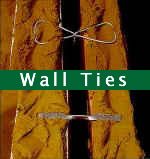Wall Ties
Most building constructed after 1920 have cavity external walls.
Typically there is an outer leaf of 100 mm thick brick work, a 50 mm wide cavity and an inner leaf of 100 mm thick brick work. The outer and inner leaves are tied together with wall ties. Wall ties in general are usually 900 mm horizontally apart and 450 mm vertically apart and are usually of galvanised steel. However, older wall ties often had a relatively thin layer of galvanising not adequate to stop the steel corroding.
Two problems exist with corroding wall ties:
Firstly, the ties can corrode in the cavity and break, the outer and inner
leaves are then no longer tied together. If this occurs there is a distinct
risk of the outer leaf collapsing especially during high winds which cause
suction on the face of the wall.
 Secondly, and probably the most common problem is when part of the tie embedded
in the outer leaf corrodes. This tends to happen on south and west facing elevations
which are exposed to driving rain and which are often wet. Rust occupies a
greater volume than the original steel and therefore the expansion of the tie
in the bed joint forces it to crack. Cracks running along the bed joints, every
450 mm up the wall, are a definite indication of wall tie corrosion. In severe
cases the outer leaf can be lifted by approximately 50 mm at roof level.
Secondly, and probably the most common problem is when part of the tie embedded
in the outer leaf corrodes. This tends to happen on south and west facing elevations
which are exposed to driving rain and which are often wet. Rust occupies a
greater volume than the original steel and therefore the expansion of the tie
in the bed joint forces it to crack. Cracks running along the bed joints, every
450 mm up the wall, are a definite indication of wall tie corrosion. In severe
cases the outer leaf can be lifted by approximately 50 mm at roof level.
A wall tie inspection would comprise of our surveyor locating wall ties by either using a metal detector, or drilling a small hole and using an endoscope to examine the condition of the ties. Alternatively a brick can be carefully removed to carry out a visual inspection, If the ties are corroded or there is insufficient ties our report and estimate designating necessary remedial work will be submitted. Obviously corroded ties will be cut out and removed to help prevent further cracking.
Also encompass with cavity wall ties are subsidence or settlement reports which are normally carried out by structural engineers. The main reason for an investigation would be to establish the cause of the problem where it is likely to get worse, and if so what action should be considered to rectify the situation. Until a site inspection is carried out, it is impossible to say which type of stitching is needed. Once an inspection has been carried out, our full report and estimate would be submitted, detailing any repairs deemed necessary.
A small fee will be incurred for our company to carry out this inspection if required

